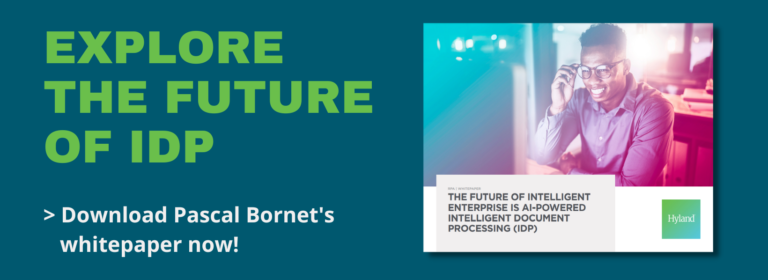Documents are everywhere — and the information contained within them is key to your organization’s success.
Think about how many employee onboarding forms, insurance claims, contracts, electricity bills, know your customer (KYC) paperwork, invoices and identification documents change hands within your organization every day. Collectively, they comprise the foundation for how your organization does business.
Most of these documents contain data in a semistructured or unstructured format — like in manuals, images, PDFs or handwritten notes. Organizations spend vast amounts of money and resources to manually process the data available in these documents, yet a massive trove of data remains hidden.
However, this manual practice is mundane, time-consuming, prone to human error and generally outdated.
Thankfully, advances in digital technology, including intelligent automation, mean there are other, smarter options for processing your documents — options that not only give your employees the time to take on more valuable work, but also get more value from the documents.
One of the most promising technologies, and the future of the intelligent enterprise, according to intelligent automation expert Pascal Bornet, is intelligent document processing (IDP).
Read the whitepaper | The future of intelligent enterprise is AI-powered intelligent document processing (IDP)
What is intelligent document processing (IDP)
Intelligent document processing (IDP) is a subset of intelligent automation that extracts, reads, interprets and acts on unstructured and semistructured data in a variety of formats. IDP uses artificial intelligence (AI) extraction capabilities to read, recognize and understand the information within templates, forms and documents — even when formatting is dynamic.
An IDP platform can work with unstructured and semistructured data in a variety of formats. It uses AI capabilities to intelligently process information within templates, forms and documents — even when formatting is dynamic. Then IDP can convert the content into structured data, which is often further streamlined by robotic process automation (RPA).
The four main components of IDP
IDP has four important components:
- Intelligent capture: Begins processing data the moment it enters your business.
- Machine learning: “Teaches” the IDP platform how to make sense of various documents and classify the data within.
- Case management: Increases visibility into an open project by providing a comprehensive bundle of information to resolve issues in a complex process (as opposed to individual documents/images). Automated workflows are an essential part of a case management solution. These automation engines facilitate the movement of cases to their outcomes, expediting the processing of documents enterprise wide.
- Robotic process automation (RPA): Emulates predictable, repetitive human actions to further process the available structured data and provides an additional layer of automation.
What differentiates IA from IDP?
Intelligent automation includes core automation technologies, such as:
- AI/machine learning (ML)
- Optical character recognition (OCR)
- Intelligent character recognition (ICR)
- Analytics
- Process mining
- Task mining
IA uses these automated technologies to create smart business processes that think, learn and eventually become self-sufficient. This helps organizations execute end-to-end processes and requires very little human intervention for exceptions.
Intelligent document processing is an integral part of intelligent automation. It uses AI and ML models to extract and interpret content and context from an organization’s documents, which means the IDP solution keeps learning over time and becomes even more accurate as it’s used.
Why is document processing important?
Intelligent document processing (IDP) is important because it can digitize and transform an organization’s documents quickly and cost effectively. It can drastically reduce the need for human intervention and decrease errors introduced by manual processing.
Manual data processing also lags behind IDP in its ability to capture massive volumes of hidden, unstructured data. To thrive in a competitive industry, it’s imperative that organizations capture and process all its data so it can drive more informed decisions.
Take an invoice as an example.
The invoice document contains important data, including the supplier’s name, the amount due, the invoice date, the invoice number and a purchase order number — but different suppliers usually fill out invoices differently. In these cases, critical information lands in different locations, the format varies (Aug. 8, 2022 vs. 8/8/22, for example), or names are spelled incorrectly, illegibly or totally omitted.
Traditionally, a human accounts payable clerk would identify the relevant data on the invoice despite the variations and enter it into a computer system. Considering the high volume of the data involved in this job, the process is time-consuming, mundane and prone to manual errors resulting in higher costs.

The benefits of intelligent document processing
There are plenty of benefits of using IDP for data processing, including:
- Competitive advantage with valuable and more efficient insights
- Enhanced and accelerated ROI
- Simple scalability across an organization
- Enhanced compliance and security by minimizing human touch and providing audit trails
- Simple integration with all applications, including legacy ones
- Increased customer satisfaction via quicker and more accurate results
- Increased employee satisfaction by freeing them of nonproductive tasks and engaging them in more strategic, meaningful work
How does intelligent document processing work?
Intelligent document processing platforms capture, ingest, process, classify, verify and validate documents and the information contained within, then deliver that data to another system as required.
An enterprise-grade IDP solution will typically follow a workflow that includes these steps: 
Document ingestion - ingest a document in electronic or paper format.
Image processing - process the document image to improve image quality.
Indexing and classification - classify a document into the correct document type using text mining and/or ML algorithms.
Intelligent data extraction and validation - Intelligently extract and validate data contained within the document. To do this, an IDP system needs to have been trained on samples of similar documents. Apply predefined validation rules to extract valid information and insights contained within the document and to categorize and organize the document itself.
Human-in-the-loop verification - IDP tools provide interfaces that permit human validation of the extracted data as needed to cut down on the use of “people” in close succession. People can check that the correct information and insight have been extracted and further improve the accuracy of the ML model by training it.
Delivery of data to another system - accurate data that has been extracted from a document can then be sent to another computer application or used in a decision-making process (e.g., ERP, CRM Snowflake or a decision model).
It takes a few months to train an IDP system using supervised learning. This training approach involves giving it correct examples to follow, consisting of a set of documents and their expected output.
Once data is extracted and made available in a structured format, IDP can be combined with RPA to automate that last leg of data processing in a business process. The combination of IDP with RPA bridges the gap between unstructured data, human verification processes and structured data that is required to automate processes.
For example, data extracted by IDP can be input programmatically into back-end corporate systems using RPA to achieve a greater level of automation or can be stored in a repository to augment strategic decision-making.
Pascal Bornet
Use cases for intelligent document processing
In any industry and any department, you will find a multitude of different document types and vast swaths of people struggling to meticulously process them with precision and speed. This means there are a lot of potential use cases for IDP. IDP offers an industry-agnostic solution for data processing.
Check out some of the many possible examples:
Finance and accounting
- Invoice processing
- Bank statements
- Collections
- Receipts
- Rebates or returns
- Tax forms
- Expense receipts
- Bank statements
Financial services
- KYC
- Insurance claims
- Account opening and closing
- Mortgage processing
- Income validation
- Identity checks
- Invoice processing
Human resources
- Employee onboarding
- Resume screening
- Identity documents
- Application processing
- Benefits management
- HR records
- References
Healthcare
- Patient registration
- Patient onboarding
- Patient records
- Processing claim-related documents
- Explanation of benefits (EOB) processing
- Invoice processing
Insurance industry
- Check processing
- Fraud detection
- Claim management
- Policy administration
- Invoice processing
Government
- Passport or vehicle license processing
- Immigration services
- Customs documents
- Invoice processing
Supply chain
- Customs declarations
- Bills of lading
- Proof of delivery receipts
- Order scheduling and tracking
- Insurance documentation
- Invoice processing
Procurement
- Purchase order processing
- Customer onboarding
- Vendor onboarding
- Contract administration
- Customer contracts
- Tenders
- Invoice processing
Manufacturing
- Sales order processing
- Data sheets
- Labels and packaging
- Customs (import/ export) documents
- Rebates and refunds
- Compliance documents
- LEED letters
- Quality assurance records
- Regulatory documents
- Invoice processing
IDP can help you unlock hidden information and value from your vast document libraries, free the intellectual capital of your workforce, enable better decision-making and transform your business into an intelligent digital organization.
The content of this blog post was adapted from The future of intelligent enterprise is AI-powered intelligent document processing (IDP) by Pascal Bornet.
This article originally appeared on Hyland.com. Inpute Technologies are proud partners of Hyland in Ireland. Our team of certified OnBase professionals are available to discuss your document processing requirements. If you’d like to talk to one of our consultants about implementing an IDP solution for your business, you can email solutions@inpute.com for more information.
.jpg)




